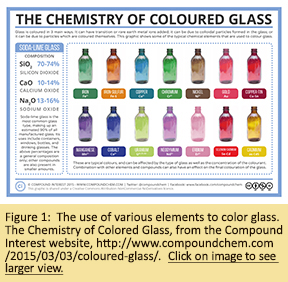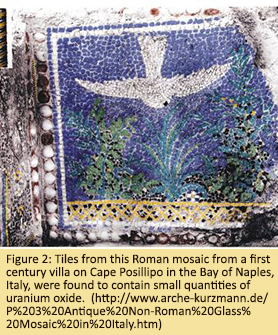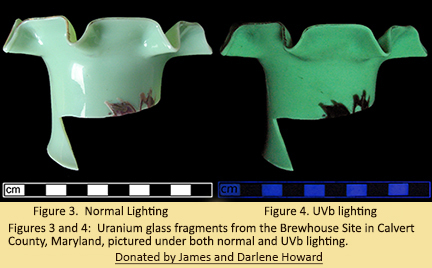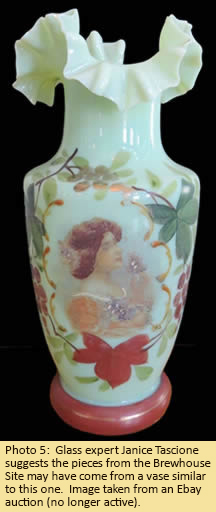October 2016
By Annette Cook, MAC Lab Public Archaeology Asst.
 During glass production throughout the ages, various metallic oxide additives have been used to produce desired colors (Figure 1.) While the most common additive is soda-lime, many metal oxides such as iron, manganese, cobalt, and copper have also been used (Compound Interest n.d.). Less commonly, uranium has been used to create yellow to yellow-green glass, which can be either clear or opaque. This glass, regardless of its appearance, has the unsettling characteristic that it glows a brilliant florescent green under UVb light. In modern times, uranium usually evokes images of nuclear plants and weapons. However, this element has been used to produce yellow-green glass for almost 2000 years.
During glass production throughout the ages, various metallic oxide additives have been used to produce desired colors (Figure 1.) While the most common additive is soda-lime, many metal oxides such as iron, manganese, cobalt, and copper have also been used (Compound Interest n.d.). Less commonly, uranium has been used to create yellow to yellow-green glass, which can be either clear or opaque. This glass, regardless of its appearance, has the unsettling characteristic that it glows a brilliant florescent green under UVb light. In modern times, uranium usually evokes images of nuclear plants and weapons. However, this element has been used to produce yellow-green glass for almost 2000 years.

Small quantities of uranium oxide have been identified in glass from 1st century Roman mosaics (Caley 1948), however the heavy metal element itself was identified by German chemist Martin Klaproth in 1789 (Figure 2). Some sources claim that Klaproth himself experimented with uranium as a glass additive. After 1820, use of the radioactive element to create yellow-green glass became popular in Europe, particularly in Bohemia. It was not until the 1830s that the glassware began to gain popularity in the US. Uranium glass was produced regularly until just before WWII, when the US government halted production as uranium became highly regulated. This moratorium lasted until 1958, when uranium oxide was deregulated, and uranium glass has continued to be produced ever since (Collector’s Weekly n.d.). Collectors must educate themselves to be able to recognize antique uranium glass from modern reproductions. 
These uranium glass vase fragments were recovered from the Brewhouse Site, a 19th-20th century plantation in Calvert County, Maryland (Figures 3 and 4). They were found beneath the plantation house, along with vast quantities of other glassware and ceramics, including a near-complete European porcelain dinnerware set and a large amount of lamp chimney glass. It is speculated that during a change of ownership, the new residents took items belonging to the previous owners and discarded them under the house. Sadly, only these two fragments of uranium glass have been located from this particular vessel. It was probably an enamel-painted and gilded vase (Figure 5), possibly produced by the northern Bohemian Harrach Glass Factory, which opened in 1712 and still produces glass today in the Czech Republic (Tascione 2016).
 Uranium glass comes in many forms and under many different names. Since the 1930s “vaseline glass” is a commonly used term for clear yellow-green glass, the name alluding to its resemblance to petroleum jelly. Other types of uranium glass include custard glass, which is milky white and opaque; jadite, an opaque whitish-green; and Burmese glass, a soft, opaque pink (Japanese Uranium Glass Collector’s Club n.d). All true uranium glasses share the same characteristic green glow under UVb light. Variations in this glow may relate to the addition of other metal oxides in a particular piece (Vaseline Glass Collectors, Inc. 2016).
Uranium glass comes in many forms and under many different names. Since the 1930s “vaseline glass” is a commonly used term for clear yellow-green glass, the name alluding to its resemblance to petroleum jelly. Other types of uranium glass include custard glass, which is milky white and opaque; jadite, an opaque whitish-green; and Burmese glass, a soft, opaque pink (Japanese Uranium Glass Collector’s Club n.d). All true uranium glasses share the same characteristic green glow under UVb light. Variations in this glow may relate to the addition of other metal oxides in a particular piece (Vaseline Glass Collectors, Inc. 2016).
While the addition of uranium to glass may seem alarming to some, the radiation emitted by such vessels amounts to less than what is naturally received from atmospheric radiation, or from granite countertops. The Nuclear Regulatory Commission has even addressed this issue in its “Systematic Radiological Assessment of Exemptions for Source and Byproduct Materials” NUREG 1717). But what about that spooky green glow? The chemistry of uranium causes the glow, NOT radiation associated with the element. If these unique glass pieces were actually radioactive enough to glow, they’d certainly be something frightful!
| References |
|
| Caley, Earle R. |
| 1948 |
The Earliest Known Use of a Material Containing Uranium, Isis. Vol. 38, No. 3/4 (Feb., 1948), pp. 190-193. |
|
| Collector's Weekly |
| n.d. |
Antique Vaseline Glass, http://www.collectorsweekly.com/glassware/vaseline-glass, website accessed 9/23/2016. |
|
| Compound Interest |
| n.d. |
The Chemistry of Colored Glass, http://www.compoundchem.com/2015/03/03/coloured-glass/, accessed 9/23/2016 |
|
| Japanese Uranium Glass Collector's Club |
| n.d. |
Colors of Vaseline Glass (Colors of Uranium Glass): Online guide compiled by the Japanese Uranium Glass Collector's Club, http://uranglass.gooside.com/kantei/ color.htm, website accessed 9/22/2016. |
|
| Tascione, Janice M. |
| 2016 |
Personal communication, 9/21/2016. |
|
| Vaseline Glass Collectors Inc. |
| 2016 |
What is Vaseline Glass? http://www.vaselineglass.org/?page_id=35, website accessed 9/21/2016 |
|